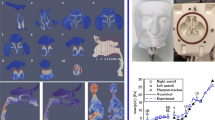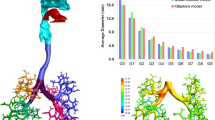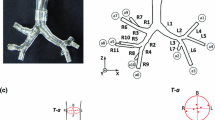Abstract
Computer simulations of airflow patterns within the human upper respiratory tract (URT) are presented. The URT model includes airways of the head (nasal and oral), throat (pharyngeal and laryngeal), and lungs (trachea and main bronchi). The head and throat morphology was based on a cast of a medical school teaching model; tracheobronchial airways were defined mathematically. A body-fitted three-dimensional curvilinear grid system and a multiblock method were employed to graphically represent the surface geometries of the respective airways and to generate the corresponding mesh for computational fluid dynamics simulations. Our results suggest that for a prescribed phase of breath (i.e., inspiration or expiration), convective respiratory airflow patterns are highly dependent on flow rate values. Moreover, velocity profiles were quite different during inhalation and exhalation, both in terms of the sizes, strengths, and locations of localized features such as recirculation zones and air jets. Pressure losses during inhalation were 30–35% higher than for exhalation and were proportional to the square of the flow rate. Because particles are entrained and transported within airstreams, these results may have important applications to the targeted delivery of inhaled drugs.
Similar content being viewed by others
References
Heistracher, T. and Hofmann, W. (1995) Physiologically realistic models of bronchial air-way bifurcations. J. Aerosol Sci. 26, 497–509.
Pedley, T. J., Schroter, R. C., and Sudlow, M. F. (1979) Gas flow and mixing in the airways, in Bioengineering Aspects of the Lung (West, J. B., eds.), Marcel Dekker, New York, pp. 163–265.
AEA Technology (1995) CFX 4.1 Flow Solver User Guide. AEA Technology, Harwell, UK.
Martonen, T. B., Zhang, Z., Yu, G., and Musante, C. J. (2001) Three-dimensional computer modeling of the human upper respiratory tract. Cell Biochem. Biophys. 35, 255–261.
Yu, G., Zhang, Z., and Lessmann, R. (1996) Numerical study of fluid flow and mass transfer in human bifurcation airways. Aerosol Sci. Technol. 25, 338–352.
Stahlhofen, W., Rudolf, G., and James, A. C. (1989) Intercomparison of experimental regional aerosol deposition data. J. Aerosol Med. 2, 285–307.
Martonen, T. B. and Zhang, Z. (1993) Deposition of sulfate acid aerosols in the developing human lung. Inhal. Toxicol. 5, 165–187.
Hahn, L., Scherer, P. W., and Mozell, M. M. (1993) Velocity profiles measured for airflow through a large scale model of the human nasal cavity. J. Appl. Physiol. 75, 2273–2287.
Keyhani, K., Scherer, P. W., and Mozell, M. M. (1995) Numerical simulation of airflow in the human nasal cavity. J. Biomech. Eng. 117, 429–441.
Schroter, R. C. and Sudlow, M. F. (1969) Flow patterns in models of the human bronchial airways. Respir. Physiol., 7, 341–355.
Zhao, Y., Citriniti, J. H., and Lieber, B. B. (1992) Flow characteristics in a symmetric bifurcation. Adv. Bioeng. ASME BED-22, 489–492.
White, Y. (1991) Viscous Fluid Flow, McGraw-Hill, New York.
Schlesinger, R. B., Bohning, D. E., Chan, T. L., and Lippmann, M. (1977) Particle deposition in a hollow cast of the tracheobronchial tree. J. Aerosol Sci. 8, 429–445.
Martonen, T. B. and Lowe, J. (1983) Assessment of aerosol deposition patterns in human respiratory tract casts, in Aerosols in the Mining and Industrial Work Environments: Fundamentals and Status, Vol. 1 (Marple, V. A., and Liu, B. Y. H., eds.), Ann Arbor Science, Ann Arbor, MI, pp. 151–164.
Martonen, T. B., Zhang, Z., and Lessmann, R. C. (1993) Fluid dynamics of the human larynx and upper tracheobronchial airways. Aerosol Sci. Technol. 19, 133–156.
Katz, I. M., Davis, B. M., and Martonen, T. B. (1999) A numerical study of particle motion within the human larynx and trachea. J. Aerosol Sci. 30, 173–183.
Martonen, T. B., Zhang, Z., and Yang, Y. (1995) Particle diffusion with entrance effects in a smooth-walled cylinder. J. Aerosol Sci. 27, 139–150.
Martonen, T. B. (1993) Mathematical model for the selective deposition of inhaled pharmaceuticals. J. Pharm. Sci. 82, 1191–1199.
Author information
Authors and Affiliations
Corresponding author
Additional information
This manuscript has been reviewed in accordance with the policy of the National Health and Environmental Effects Research Laboratory, U.S. Environmental. Protection Agency, and approved for publication. Approval does not signify that the contents necessarily reflect the views and policies of the agency, nor does mention of trade names or commercial products constitute endorsement or recommendation for use.
Rights and permissions
About this article
Cite this article
Martonen, T.B., Quan, L., Zhang, Z. et al. Flow simulation in the human upper respiratory tract. Cell Biochem Biophys 37, 27–36 (2002). https://doi.org/10.1385/CBB:37:1:27
Issue Date:
DOI: https://doi.org/10.1385/CBB:37:1:27




